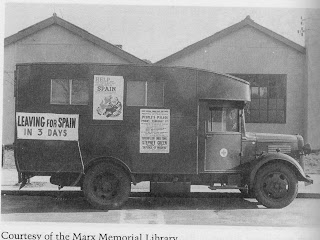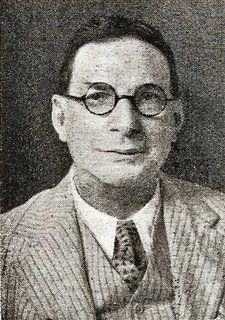
Lily "Margaret" Powell (Picture above second left) was born the daughter of a farmer at Cym Farm, Llangenny, in the Welsh Black Mountains on 26th March 1913.
She qualified as a nurse in London (living in Southwark), She joined a nursing union (I believe Thora Silverthorne's Association of Nurses, which later joined NUPE.
later she undertook midwifery training, While undertaking her training, Margaret Powell volunteered to nurse in Spain as part of the British Medical Unit organised by the Spanish Medical Aid Committee (SMAC). Which supported the Republican cause during the Spanish Civil war.
However she was advised by Leah Manning (SMAC) to finish her training first, which she did, finally arriving in Spain in early 1937
 She married International Brigadier Sam Lesser (known as Sam Russell when writting for the Daily Worker) who she meet when he was on leave in Barcelona from the front and she was recovering from a broken leg
She married International Brigadier Sam Lesser (known as Sam Russell when writting for the Daily Worker) who she meet when he was on leave in Barcelona from the front and she was recovering from a broken leg
Margaret Powell was the last British International Brigade nurse to leave Spain, in January 1939, losing her passport in the chaos of the retreat into France of thousands of Republican refuges from Franco’s fascist.
At the border she was arrested by French police and taken to the refugee camp at Argeles-sur-Mer, where 70,000 refugees lived on sand dunes with no shelter and in appalling conditions. she was finally rescued by Richard Rees from a Quaker Relief team
Margaret Powell was one of the most outstanding nurses who went to Spain and was later created a Dame of the Order of loyalty to the Spanish Republic "for her valiant action as a nurse...for her faith, self-sacrifice and devotion to our wounded and to our war victims" .
A plaque was unveiled in Southwark Councils, Mayor's Parlour on 6th November 1986 to commemorate those who fought or nursed in Spain for the International Brigade, this plaque included Margaret Powell.
Bill Alexander; Constantine Augherinos; Harry Bourne; Jock Cunningham; Dr Len Crome; Margaret Powell (Nurse); Heracles Augherinos; Paul Dewhurst;Dougal Eggar; Harry Evans; Joe Fuhr; Dave Gibbons; George Hardy; Jim Hoy; Jack L Jones; Lou Kenton; John Riordan; Ted Smith.
Ann Murray after Spain nursed at Dulwich Hospital and Halcrow Verstage a young architect who was the son of London County Council surveyor for Sydenham who had been educated at Alleyn's School, Dulwich
British Nursing Journal April 1938
NOTES FROM THE ARAGON FRONT
 "After spending several months in a small village on the Aragon front serving at an urgent surgical centre, the division to which we' were attached became a " shock division " moving from place to place, we, as the mobile surgical team moving with it. "We reached the end of our journey, which was high up in the Pyrenees, at midnight, and for the rest of the night we heard mules and trucks go by towards the front line—in some places less than four miles away.
"After spending several months in a small village on the Aragon front serving at an urgent surgical centre, the division to which we' were attached became a " shock division " moving from place to place, we, as the mobile surgical team moving with it. "We reached the end of our journey, which was high up in the Pyrenees, at midnight, and for the rest of the night we heard mules and trucks go by towards the front line—in some places less than four miles away.
Early next day we commenced making our preparations, selecting for the theatre a shed which had been used as a slaughter house (there was no other choice). At least it had the virtue of a roof, even if some of the walls were missing. Blankets were hung where the walls should have been, whilst the remaining walls were white washed and the mud scraped off the floor.
"Whilst this was in progress we sat on mattresses by the roadside and repacked our few, but so precious, drums, and some men cleared a pumpkin patch and erected two fairly large tents, cleaned a couple of sheds, and put up beds for the wounded on the uneven mud floors. So hard did we. work that by nightfall everything was ready. The theatre was as clean as it could be made, furnished with an operating table, the handbowl from the operating ambulance, to which water ran through a hosepipe from. a hand-filled tank outside the door—a small square wooden table complete with drawer; that useful drawer! A large packing case contained all- the theatre linen and spare drums (one of each) with the other drums on top.
A wooden box containing our treasured English soap serving as a stand for the lotion bowl, an old box containing all our anaesthetics, and a stool. Mails were driven into the walls to accommodate the rubber aprons, rain-coats, etc. The " wards " were fitted with a couple of boxes to serve as tables, the beds being made up only with blankets, for we had no sheets, and not many pillows.
All the afternoon and evening we heard the sound of battle, and we knew that soon our period of "idleness" would cease. The wounded began to arrive at about six o'clock in the morning, a grim contrast to the loveliness of the Pyrenees, and we started our work without doing more than struggle into our clothes and washing our hands.
In addition to being surgically responsible for our own division of over ten thousand soldiers, we were also detailed off to attend another three thousand men because their division had no surgeon.
All the wounded, many of whom had to be brought down from the mountains on mules, were first treated at the First Aid Stations, and then came on to us. Ambulance after ambulance "six abdominals and a couple of heads—all for operation." Next one : more abdominals, more heads,' compound fractures, " all for operation." And for all this, only one surgeon—Spanish—who just goes on and on, speaking only to enquire what is next;' making anxious enquiries about the state of the last case ; asking about the stock of sterile material, and above all passing never-failing words of encouragement to the wounded, even after twenty-four hours of constant work!
We had no electricity, but worked with primus lamps and candles and when all the mantles broke, just candles. Imagine if you can, a surgeon performing a laparotomy, finding and suturing a liver wound, or maybe 24 or more intestinal perforations, performing a nephrectomy, removing a spleen, all by candlelight. Meanwhile we grope around the table for instruments, thread needles, break catgut capsule all in the flickering light.
The lighting question was still more acute in the "wards." We had to strike matches to look at the patients whilst blood transfusions had to be given with the aid of a cigarette lighter. One nurse looked after the wards and we were so overcrowded that very often both tents (our offices and sleeping quarters) were filled with -wounded, either waiting for operation or evacuation.
For obvious reasons we were never able to "scrub up," nor had we enough gowns for the surgeon let alone for ourselves. The two of us who worked in the theatre looked after everything. We looked after the surgeon, threaded needles, broke catgut capsules with forceps, washed instruments, towels, etc.; packed drums and sterilised them on primus stoves—inside if it was windy, and by the road-side if it was fine. We only had two drums of everything so we were constantly sterilising. The folding of gauze was perhaps our greatest worry, but we always just managed it, folding some ourselves at odd minutes, seizing on every other person with empty hands.
During the few and far between periods when we were not operating, we cleaned the instruments and needles—in instalments because we kept them always sterile in alcohol—boiling water on a primus stove being a much too lengthy affair. We mended our too few gloves, some of them have as many as 36 patches, whilst there was the linen to be darned and rubber aprons to be patched.
We endeavoured to keep all the severe abdominal cases for at least 48 hours, but often they had to be evacuated before they were properly round from the anaesthetic to a hospital about 40 miles further down, by a road which was like a spiral staircase without walls. The conditions in which the wounded were nursed were the best we could make them. Taking into consideration the coldness of the weather, the many hours before we got them for operation and the lack of competent staff to care for them as well as the lack of means of supplying warmth such as blankets, hot-water bottles, etc., the results were very good.
Blood transfusions were given whenever possible, but we could not employ the tubes of blood because we had no refrigerator in which to store them, so the direct method was always used. There were times when it was impossible to find a donor, for everyone within reach had given as much as they could.
We were. I suppose, always in some sort of danger, but somehow when one is surrounded by danger one does not think of it, and in any case we did not have the time to worry. The only fear which haunted us was the fear that we should not have enough material with which to work. There are things which the Spanish people are able to supply us with, but there are many necessities they cannot provide. We depend on our Committee for these, and so far they have not failed us. The thought that some day they might have to stop supplies through lack of funds is too terrible to contemplate.
I can hardly say how urgently nurses are needed. When one has had to see men, young, strong and brave, a" because nobody had time to give a blood transfusion, salines, or some sort of attention which in many cases would have made all the difference, it is difficult to or rational about it. We do all that is humanly possible, more indeed than I once thought possible, but there is so very much more that could be done if only there were more of us. If you could know the Spanish people as I have come to know them, you would find the ordinary people brave and kind, fighting not because they love bloodshed as many people would have you believe, but bloodshed know that they MUST fight to save their homes and for the right to live peacefully and decently. They feel and indeed they know that the victory of the Fascist force would mean tyranny and oppression for them and for Spain.
MARGARET POWELL, S.R.N., S.CM.
Michael Walker
 Hayes Cottage Hospital Occupation (Work-in) for 24 hours circa 1990 organised by COHSE Hillingdon & District Branch. This was the second occupation in opposition to the proposal to sell off Hayes Cottage Hospital and was successful in securing redeployment for all staff within the NHS.
Hayes Cottage Hospital Occupation (Work-in) for 24 hours circa 1990 organised by COHSE Hillingdon & District Branch. This was the second occupation in opposition to the proposal to sell off Hayes Cottage Hospital and was successful in securing redeployment for all staff within the NHS.






